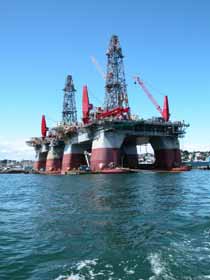Offshore Oil Rig Jobs
Life on an offshore oil rig is very different from life on an onshore rig. Workers on offshore rigs need to be smart and savvy and aware of the risks involved. In places like the Gulf of Mexico, tropical storms and hurricanes are just a sample of what can go wrong. Offshore oil rigs basically function as a small floating city. Their sizes range from small rigs to rigs that have platforms whose size rivals football fields and whose derrick height rivals skyscrapers.
Even with the apparent dangers of storms and hazardous seas, life on an offshore oil rig can be a welcoming challenge with huge rewards. Most jobs on offshore oil rigs start out at $45,000 a year and could potentially rise up to $100,000+ a year. Workers stationed on rigs that are located miles from shore are housed on barges that are attached to the offshore platforms or in units that are built right into the rig. Life on these offshore rigs does resemble onshore life in some aspects. Workers are reasonably accommodated with showers, food, TV, phones and laundry facilities, but workers should prepare to get familiar with the employees that are around. They may be the only human contact for two or three weeks.
The work schedule on an offshore rig is almost a set routine. Workers offshore are typically on the job for 12 hours a day for seen straight days before they are given a weeklong break back on shore. Some rigs, however, require that their workers operate in two or three week shifts, which means two or three weeks of 12 hour days on the rig followed by two or three weeks off the rig. Workers do need to work a night shift occasionally to maintain the rigs 24 hour operation. While on the job, workers are required to wear hard hats, safety glasses, coveralls and safety boots. Interestingly enough, smoking is not banned on offshore oil rigs, but smokers must be careful to smoke only in the designated areas to avoid any explosions.
The offshore rig offers a unique commute experience. On rigs that are only a few miles from shore, a quick ride on a barge is all that is needed. However, on some Gulf of Mexico oil rigs located more than 20 miles from shore, a helicopter is required to reliably and safely transport workers to their destination.
Perhaps above all, it is important for an offshore oil rig worker to have a good attitude. You will be working with people in very close quarters, and even the smallest disturbance between workers can have implications for the entire rig.


 Teach English in Asia
Teach English in Asia  Cruise Ship Jobs
Cruise Ship Jobs  Alaska Fishing Industry Jobs
Alaska Fishing Industry Jobs  Sharing Economy / Gig Economy
Sharing Economy / Gig Economy 